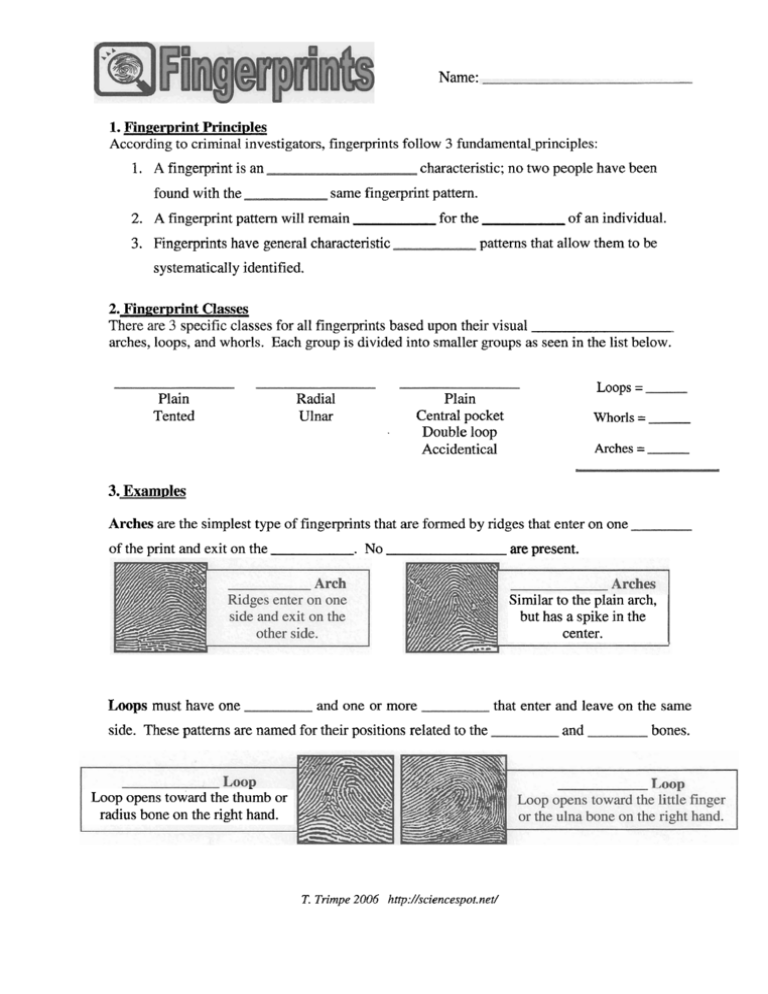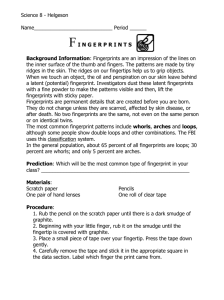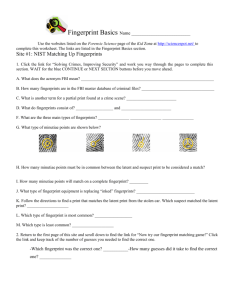1. Fingerprint Principles 2. Fingerprint Classes 3. Examples . No
advertisement

Name: 1. Fingerprint Principles According to criminal investigators, fingerprints follow 3 fundamental-principles: 1. A fingerprint is an characteristic; no two people have been same fingerprint pattern. found with the 2. A fingerprint pattern will remain for the 3. Fingerprints have general characteristic of an individual. patterns that allow them to be systematically identified. 2. Fingerprint Classes There are 3 specific classes for all fingerprints based upon their visual arches, loops, and whorls. Each group is divided into smaller groups as seen in the list below. Plain Tented Radial Ulnar . Loops = Plain Central pocket Double loop Accidentical Whorls = Arches = 3. Examples Arches are the simplest type of fingerprints that are formed by ridges that enter on one of the print and exit on the . No are present. Similar to the plain arch, but has a spike in the center. Loops must have one and one or more that enter and leave on the same side. These patterns are named for their positions related to the Loop opens toward the thumb or radius bone on the right hand. T. Trirnpe 2006 hnp://sciencespot.net/ and bones. that makes (or tends to make) a complete Whorls have at least one deltas. If a print has more than two deltas, it is most They also have at least likely an Draw a line between the two deltas in the plain and central pocket whorls shown below. If some of the curved ridges touch the line, it is a plain whorl. If none of the center core touches the line, it is a central pocket whorl. Label each fingerprint below. whorls are made up of any two loops combined into one print. 4. Identify each fingerprint pattern shown on the class notes. A. C. B. D. E. 5. Follow your teacher's directions to document your fingerprints on the My Prints worksheet. Use your notes and a magnifying glass to identify the pattern in each one. .. ... . -.. '...>-. I ..->-.:. : -<:-. :. '.iY -.-.= :-.. ._ \ T. Trimpe 2006 http://sciencespot.net/ Name LeE?t - T.Trinzpe 2006 http://sciencespot.net/ Make fingerprints for each hand and then classify them according to the types presented in class. L Name Step 1: Classify your fingerprints and record the number of each pattern below. Your total should equal 10! Loops = Arches = Whorls = Step 2: Complete the chart below by recording the total number of each pattern for the class. The expected averages are 60% for loops, 35% for whorls, and 5% for arches. Pattern # Total Prints % Arches Loops Whorls How do our prints compare to the expected averages? Step 3: Complete the chart below by recording the total number of each pattern for the males and females in the class. Pattern # Males # Females Total Prints Arches Loops Whorls Which pattern is most common pattern among the males in this class? Which is most common pattern among the females? How do the averages for each sex compare to the expected averages? T.Trimpe 2007 http://sciencespot.net/ % Fingerprint Basics Name Use the websites listed on the Forensic Science page of the Kid Zone at http://sciencesuot.netI to complete this worksheet. The links are listed in the Fingerprint Basics section. Site #I: NIST Matching Up Fingerprints 1. Click the link for "Solving Crimes, Improving Security" and work you way through the pages to complete this section. WAIT for the blue CONTINUE or NEXT SECTION buttons before you move ahead. A. What does the acronym FBI mean? B. How many fingerprints are in the FBI master database of criminal files? C. What is another term for a pjlrtial print found at a crime scene? D. What do fingerprints consist of? and F. What are the three main types of fingerprints? G . What type of minutiae points are shown below? H. How many minutiae points must be in common between the latent and suspect print to be considered a match? I. How many minutiae points will match on a complete fingerprint? J. What type of fingerprint equipment is replacing "inked" fingerprints? K. Follow the directions to find a print that matches the latent print from the stolen car. Which suspect matched the latent print? L. Which type of fingerprint is most common? M. Which type is least common? 2. Return to the first page of this site and scroll down to find the link for "Now try our fingerprint matching game!" Click the link and keep track of the number of guesses you needed to find the correct one. - Which fingerprint was the correct one? - How many guesses did it take to find the correct one? T. Trimpe 2006 http://sciencespot.net/ Site #2: TruTV Fingerprint Game Choose the "Fingerprints Game" link and follow the directions to match the prints. Try the game at least 5 times and record your efforts in the chart. To identify the prints, use the corresponding letters below. Correct Site #3: PBS Whodunit? Click the link for "Whodunit?" Read the information presented and follow the directions to complete this activity. What was the crime? Where? What time did it happen? How many people were involved? How many fingerprints did you collect from the bank? How many other fingerprints did you find that could not be used? Who are your main suspects? Why would you fingerprint the bank employees? Follow the directions to match prints from the evidence files to the ones in the fingerprint files. Which person was responsible for the crime? Done? Try the games listed below. The links are listed in the Mysteries & More section. CI The Mystery of the Hidden Mine - Who did it? Burgled Bonuses -Who did it? Don't forget to turn in your worksheet! T. Trimpe 2006 http://sciencespot.net/ Name Make toe prints for each foot and then classify them according to the types presented in class. How do your toe prints compare to your fingerprints? T. Trimpe 2006 http://sciencespot.net/





